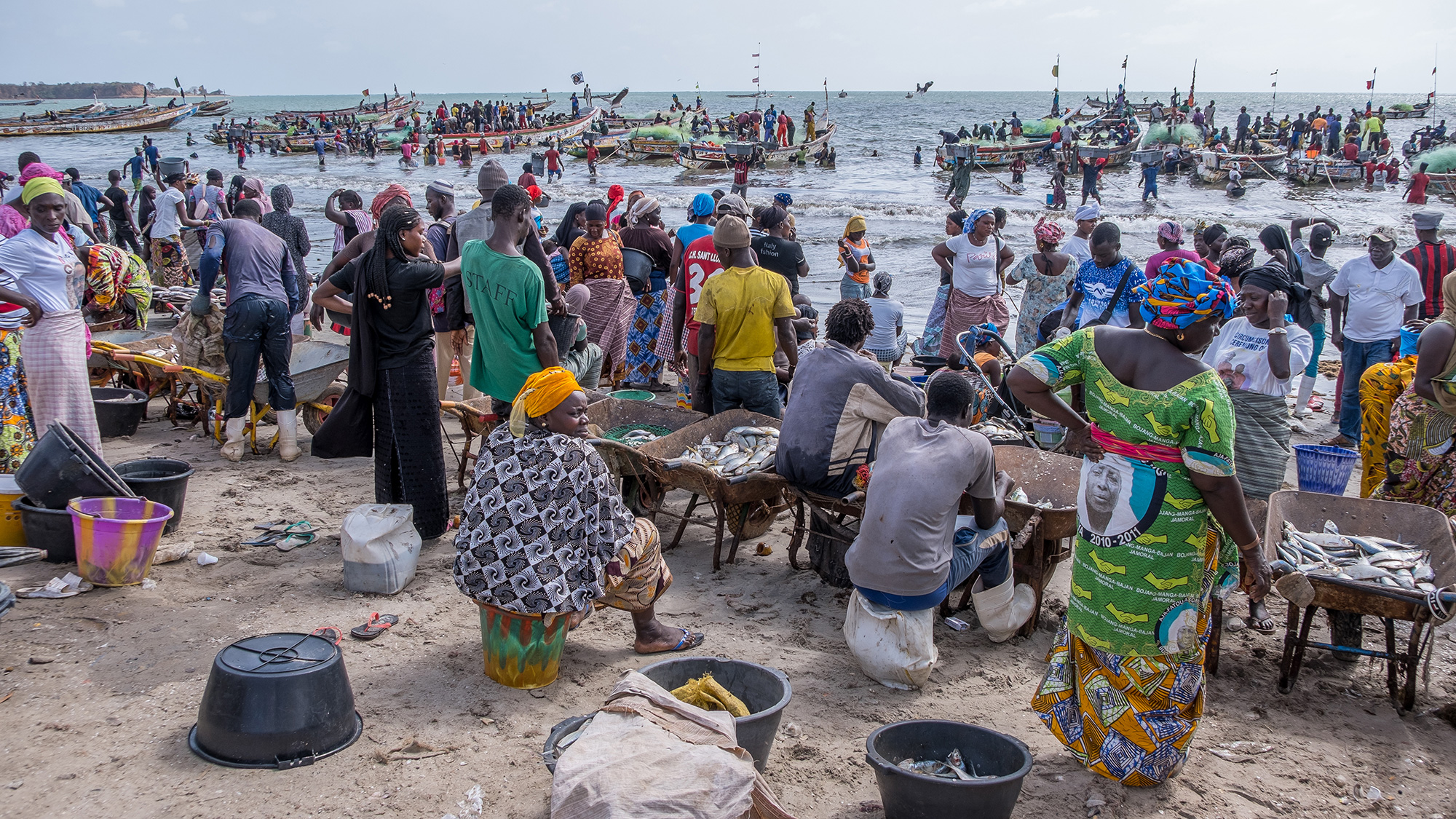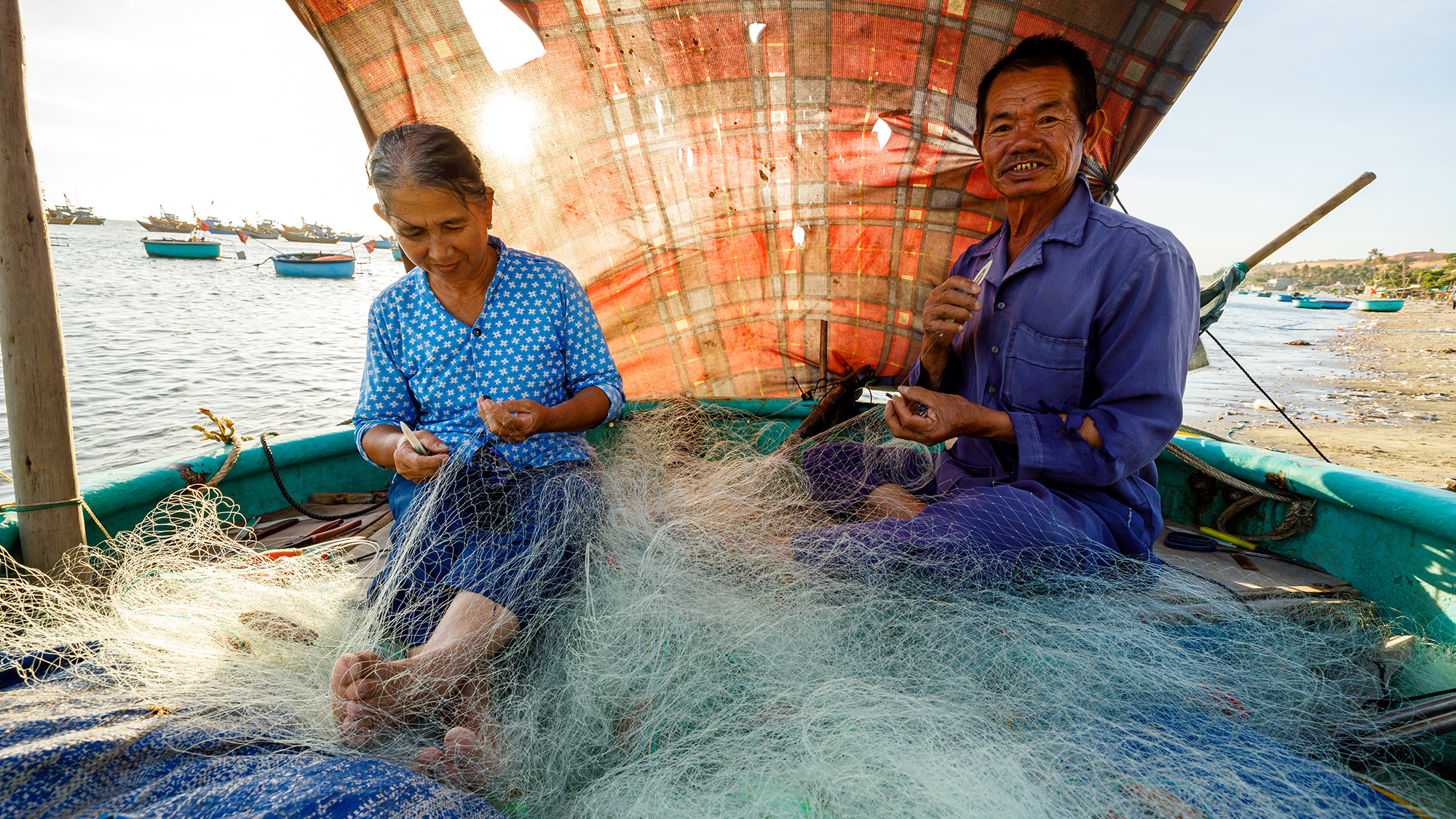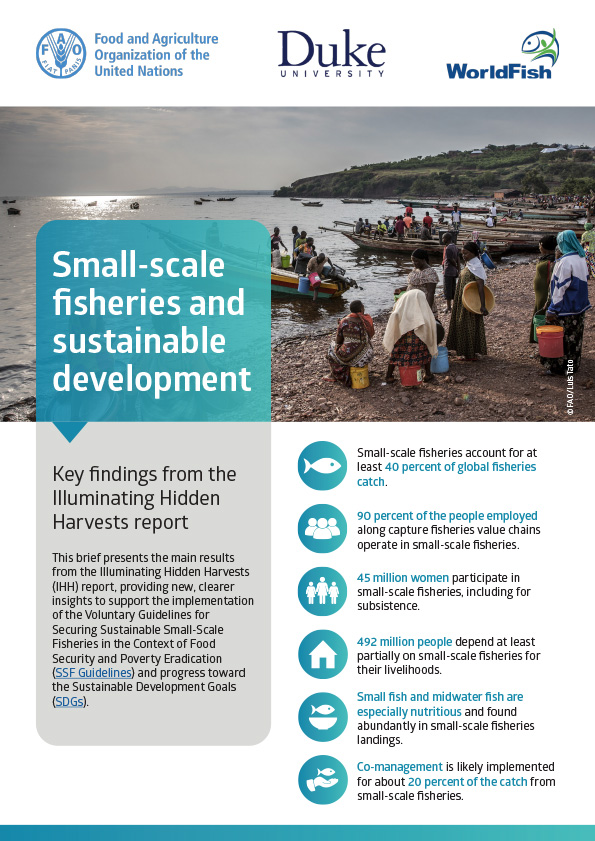The World Bank is the largest funder of marine small-scale fisheries (SSFs) globally, having allocated roughly USD 1.2 billion to SSFs over the last 50 years. Our Shared Seas checked in with Xavier Vincent, Lead Fisheries Specialist at the World Bank, to explore the ways in which funding from the development sector and philanthropy can work in concert to support SSFs.

An estimated 45 million women participate in small-scale fisheries. Photo: iStock. Sumbawa, Indonesia.
Can you offer a high-level orientation to the World Bank’s current engagement on SSFs and describe how this fits in with the institution’s larger portfolio of work globally?
Starting in 2005, the World Bank created a global program, PROFISH, that helped the Bank make the case for why it should invest in fisheries, especially SSFs. Fisheries projects are difficult, complex, and time consuming, and improvements can be hard to see—all of which are complicating factors. But several forces are showing that improving fisheries, and SSFs in particular, is meaningfully aligned with the twin goals of the World Bank: reducing extreme poverty and increasing shared prosperity.
- First, the financial crisis in 2008 opened the eyes of clients and management to the importance of food security and sovereignty. Fisheries are a major source of protein for millions of people.
- Second, climate change is leading to reduced productivity in agriculture and fisheries (including aquaculture), and this is only going to get worse. So we must manage fisheries for environmental sustainability to improve climate resilience, avoid overexploitation, and the long-term loss of this critical resource.
- Third, COVID-19 and Russia’s invasion of Ukraine are highlighting the importance of food security and sovereignty and livelihoods. This is re-focusing attention on fisheries, especially SSFs.
Since PROFISH started in 2005, the Bank has expanded its fisheries work dramatically, from west Africa to east Africa and the Indian Ocean, then to the Pacific and Caribbean, and now to South and East Asia.
In all these places, the first priority is establishing effective fisheries management for sustainability. The second priority is sustainable development of the fishery through sustainably increasing economic and other benefits and ensuring their fair distribution. We think of economic benefits not just in the sense of money, but also in terms of well-being, protein, livelihoods, and even the spiritual aspect. It is redefining wealth. You can see this in the link to natural capital accounting—we are finding new ways to account for capital that also support the aspirations of the population.

The forthcoming Illuminating Hidden Harvests report highlights the food security and nutrition contributions of small-scale fisheries. Small fish and pelagic fish are especially nutritious and found abundantly in SSFs landings. Photo: iStock. The Gambia.
Do you have any pragmatic recommendations for a funder considering either entering SSFs or deepening its work in this space? What are the areas that development funders are uniquely positioned to support?
The development sector is in a better position to support management than private investors because it is difficult to recoup your investment in fisheries management—theoretically, everyone benefits from improved management in an open-access fishery. So this is where development and philanthropic funds are needed.
Philanthropic and development funding can be complementary. As you know, the World Bank is a bank; it is generally about credit and loans. But a country may be reluctant to borrow money to support fisheries management because the outcomes are difficult to see and therefore difficult to justify to their citizens. Some governments prefer investing in infrastructure because it is easier for the population to see what the money (and debt) made possible. Grant funding from philanthropy can be helpful when a client is not yet ready to borrow.
We think of economic benefits not just in the sense of money, but also in terms of well-being, protein, livelihoods, and even the spiritual aspect. It is redefining wealth [and] we are finding new ways to account for capital that also support the aspirations of the population.
What are some of the common obstacles for development funders to supporting SSFs, and how has your team sought to address this in your work?
Some of the biggest challenges are the following:
- The time scale is long term: We are talking about people and changing the way they fish, or stopping or reducing fishing, and diversifying livelihoods. That can’t happen overnight—it may take several generations. My first question when I joined the Bank was: how long? This is a program, not a project. It is a suite of iterative investments working toward long-term change. We have to accept the risks of this long-term engagement.
- Benefits are difficult to measure and prove: If I need to build a road, I know how wide and long it must be and how much tarmac I need, and I can show everyone what I have completed. Fisheries usually do not work this way because it often takes time before the fisheries resource bounces back, and decision-makers and managers can be short-sighted. This makes it difficult to measure and show improvement. For this reason, the forthcoming Illuminating Hidden Harvests report will be helpful—we need a baseline and dashboards for characteristics of SSFs.
- Transparency: Information should be made available, and people should be able to understand the work and its objectives and goals. We need clarity on program objectives and goals, as well as reporting on management efforts and development results. But sometimes this information is missing.
- No one-size-fits-all: Solutions must be tailored to local conditions. Governments often want to do everything, but stakeholders may have mutually exclusive objectives. For example, countries want to export more and feed their populations, or produce more while promoting sustainability. They must decide how to distribute these efforts. They might, for instance, have an objective for certain small-scale fisheries to focus on livelihoods; other fisheries to focus on food security and sovereignty; and other fisheries could be developed for export.
Philanthropic and development funding can be complementary. As you know, the World Bank is a bank; it is generally about credit and loans. Grant funding from philanthropy can be helpful when a client is not yet ready to borrow.

The forthcoming Illuminating Hidden Harvests report estimates that 492 million people depend at least partially on small-scale fisheries for their livelihoods. Photo: iStock. Puerto Lopez, Ecuador.
Beyond the World Bank, what does the state of play currently look like for funder engagement with SSFs? Can you share a brief orientation to the leading agencies or initiatives engaged on this work?
Based on experience in the Pacific, governments are starting to recognize fisheries’ importance as a food source, not just a revenue source. The World Bank has a fisheries program in the Pacific now entering the second phase. In the first phase, there was a mix of fisheries—industrial large scale, coastal (mostly SSFs), and some habitat-oriented work. The initial focus was on large-scale fisheries because they are a big driver of revenue. But in the last few years, the governments have gained interest in the coastal fishery because of improved understanding of the fishery’s importance for the well-being of people—an even more important consideration given the impacts of and lessons from the COVID-19 pandemic, and the current crisis in Ukraine. The government also realizes the SSF sector provides a highly energetic and nutritious food compared with imported food, which can lead to the transfer of non-communicable diseases.
So at least in the Pacific and parts of East Asia like Indonesia, the importance of SSFs is better understood, and government investment is increasing because there is demand for it. I believe this may represent a global trend, as well.
I am somewhat concerned, speaking personally, that the blue economy discussions and concept may divert interest from SSFs. We need to address the existing problem before we go on to solve new ones. In my opinion, the new blue economy efforts may entail doing too much at once and may disrupt the SSF agenda. We need to address these issues in a holistic way, including interactions with tourism, coastal development, and more.
Based on experience in the Pacific, governments are starting to recognize fisheries’ importance as a food source, not just a revenue source. So at least in the Pacific and parts of East Asia like Indonesia, the importance of SSFs is better understood, and government investment is increasing because there is demand for it.

Co-management is likely implemented for 20% of SSFs catch. Understanding the governance dimensions in SSFs is a priority to ensure that the voices of fishers and fishworkers are represented at a policy level. Photo: iStock. Valparaiso, Сhile.
Do you see opportunity for philanthropy and the development sector to collaborate on SSFs? If so, what can each sector bring to complement each other and generate the greatest impact?
There are three places where collaboration works well:
- Financial gaps: In the direct investment context, when we engage with a client and identify their needs, we recognize that some clients are not ready to proceed with a loan from the World Bank, potentially due to differences in priorities or credit issues. The World Bank provides the money to governments, but they are the ones choosing what to do and what to implement. We can decline to fund certain efforts, and we can suggest what to fund, but we cannot impose our will. When we identify a financial gap, philanthropy can come in and we can coordinate funding the activities government needs but is not ready to finance with the Bank. This is particularly relevant for science and management activities.
- Technical gaps: Not all issues can be addressed by money. We also need a strong partner at the international level, a center of excellence that provides technical solutions to countries, and exchange across countries. The Food and Agriculture Organization (FAO) of the United Nations is a key partner. So there is a need for broad coordination. As a bank, we have some technical knowledge but cannot reach the full global SSF agenda. Participation of philanthropy is also very welcome to support this agenda.
- Knowledge creation: This can be very expensive and difficult to justify, when resource are scarce and competition exists for allocation of resources to different priorities domains such as education, health, energy, transport, etc. Philanthropy can play a complementary role by helping identify the data needed to manage a sector—including what is needed to track and monitor to reach objectives in a cost-effective way. Governments need to train people to collect, process, use, and understand the data. Although the Bank tries to support these long-term, difficult engagements, we might have relatively little ability to help in this domain. Philanthropy can be valuable in helping to build an evidence base and make the case.
It is critical that this knowledge creation is done in collaboration with government. Further, it must be embedded in long-term practices and operations so it is not dependent for support on an NGO or a single individual within the government.
When the World Bank identifies a financial gap, philanthropy can come in and we can coordinate funding the activities government needs but is not ready to finance with the Bank. This is particularly relevant for science and management activities.

Women tend to be overrepresented in informal and unpaid activities in the SSFs sector – including subsistence fishing activities such as gleaning, and informal activities that support fishing businesses and operations – which are rarely accounted for in official fisheries statistics. Photo: iStock. Vietnamese fishers repairing a fishing net.
Looking forward, what are you most excited about and what do you see as future directions for this field? Where can the development sector help play a leading role, from encouraging innovation to facilitating safeguards for SSFs?
Because of climate change, I see the importance of the SSFs sector growing, so I am excited about the prospect of increased government interest. Because the sector’s importance is more recognized and the issue is more central, I expect significant future engagement with the sector.
We also need to break the silos between the various sectors, such as agriculture and energy, and find solutions together within the fisheries sector. For example, if we have too much fishing pressure, we need diversification of livelihoods, which requires engaging the education sector to support access to new jobs for the next generation. Working with other sectors is key.
This integrated approach is growing within the Bank. Silos existed for many years, but the situation is improving now. I’m seeing more discussion and collaboration with the social protection sector and financial sector, combined with instruments to support management and sustainable development. There is also more discussion with the agricultural sector about the idea of fisheries as part of the production model. Often, fishers do not only fish but also farm or make handicrafts. Overcoming historical silos is the next challenge (and opportunity).
Because of climate change, I see the importance of the SSFs sector growing, so I am excited about the prospect of increased government interest. Because the sector’s importance is more recognized and the issue is more central, I expect significant future engagement with the sector.
Download the brief and infographic from the forthcoming Illuminating Hidden Harvests report by the FAO, Duke University, and WorldFish.


